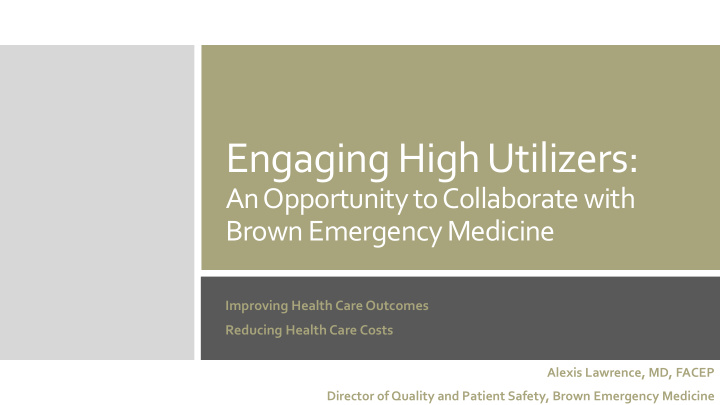



Engaging High Utilizers: An Opportunity to Collaborate with Brown Emergency Medicine Improving Health Care Outcomes Reducing Health Care Costs Alexis Lawrence, MD, FACEP Director of Quality and Patient Safety, Brown Emergency Medicine
1-5% of the patient population seen in the ED account for up to 18% of all annual ED visits and 40% of emergency healthcare costs
Mental and behavioral Substance use disorders health comorbidities Changing social needs : Complex chronic medical housing insecurity, food conditions : COPD, insecurity, legal issues, diabetes, heart failure access to care
High utilization Frequent ED visits Frequent hospital admissions Disproportionate cost Poor health outcomes Increased risk overdose Increased mortality
Provider dissatisfaction No Poor patient outcomes standardized Poor communication approach Overlapping services
Community Health Workers Social Workers Interdisciplinary Case Managers team Nurses Physicians
Bridge
CHWs community based advocates for 20-30 high utilizers Focus on increased adherence to outpt appointments, coordination with community resources Project Overview Track pre/post intervention health care encounters and costs as well as patient centered outcomes Anticipate decreased ED utilization, decreased hospital admissions, decreased health care costs, improved outpatient visit compliance, improved health outcomes
RIH DOH Community Health Worker Certification program • Focused training, local expertise Lifespan Community Health Institute Strengths • Administrative and operational support Brown Emergency Medicine • Medical oversight and academic vision
Patients with >6 visits to RIH and/or TMH ED May 1 2018- April 30 2019 2,751 28,383 patients encounters
6-30 visits: 2669 Utilization 30-60 visits: 54 Brackets 60+ visits: 26
RACE GENDER White Black Other Male Female 21% 43% 57% 60% 19% Demographics ETHNICITY Hispanic Non-Hispanic 20% 80%
PAYOR Self Pay 7% Medicaid 10% Neighborhood 30% Payor Distribution Commercial 14% United Medicare 21% 18%
Disposition Other 3% LWBS 9% Patient Admit 27% Disposition Discharge 60% Admit Discharge LWBS AMA Other
Data analysis/population health CHWs direct patient advocacy and EHR support Project Overview Track pre/post intervention health care encounters and costs as well as patient centered outcomes Anticipate decreased ED utilization, decreased hospital admissions, decreased health care costs, improved outpatient visit compliance, improved health outcomes
Comorbid medical, mental health and substance use disorders Social determinants of health Data Analysis: Future State Evaluate practice variability within ED Existing outpatient resources
Community based advocacy: 20-30 patients/CHW CHW impact EPIC care plan optimization: 100+ patients/CHW
Projected decrease in hospital admissions, ED encounters Based on current data: Cost Analysis • 28,383 encounters • 27% admission rate, 60% discharge • 7,663 admissions annually from high utilizer population • $2164 avg daily cost hospital admission $16.6 M annually • 17,000 discharge visits at $500 $8.5M annually
Decrease in HU admissions and ED visits by 5% would translate into $1.25M saved
CHW salary and Physician benefit: $100,000 oversight: $80,000 Program Costs Transportation: Phones: $8,000 $12,000
Full funding support: BEM willing to collaborate with payors or ACOs to focus on targeted patient population segment for POC Partnership opportunity: partial financial support for initial 2 years of data collection Opportunities Data collaboration: identifying gaps Improved communication: standardizing care
Better care. Lower costs.
Recommend
More recommend